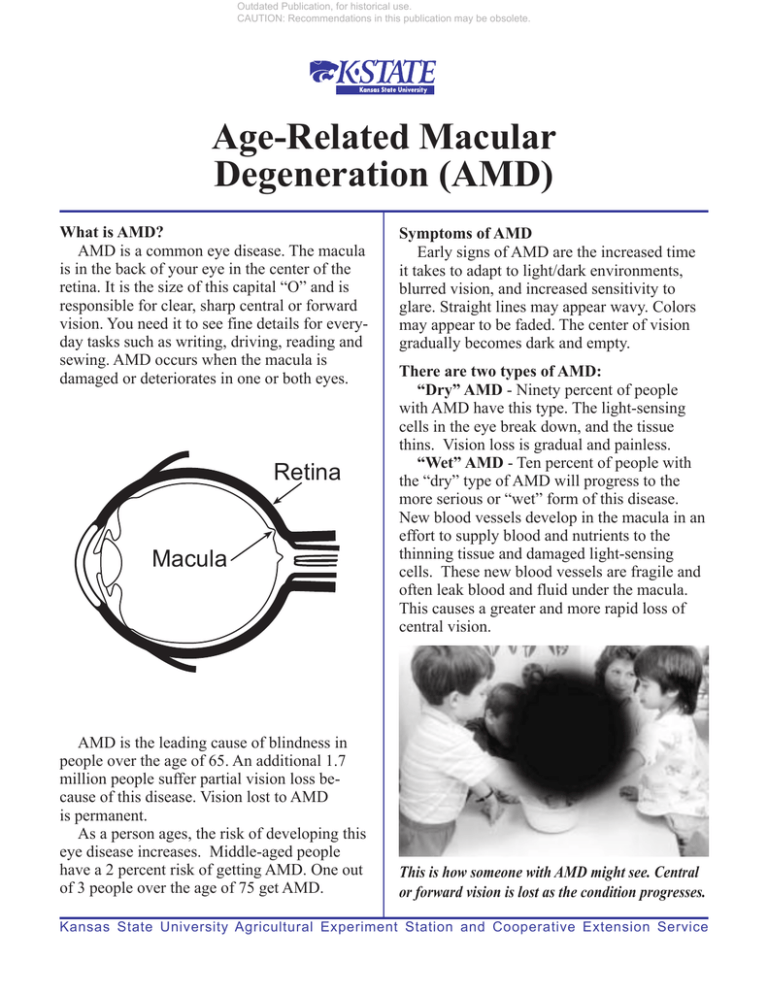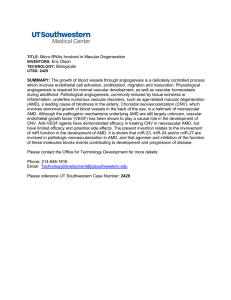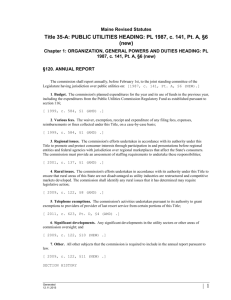
Outdated Publication, for historical use.
CAUTION: Recommendations in this publication may be obsolete.
Age-Related Macular
Degeneration (AMD)
What is AMD?
AMD is a common eye disease. The macula
is in the back of your eye in the center of the
retina. It is the size of this capital “O” and is
responsible for clear, sharp central or forward
vision. You need it to see fine details for everyday tasks such as writing, driving, reading and
sewing. AMD occurs when the macula is
damaged or deteriorates in one or both eyes.
Retina
Macula
AMD is the leading cause of blindness in
people over the age of 65. An additional 1.7
million people suffer partial vision loss because of this disease. Vision lost to AMD
is permanent.
As a person ages, the risk of developing this
eye disease increases. Middle-aged people
have a 2 percent risk of getting AMD. One out
of 3 people over the age of 75 get AMD.
Symptoms of AMD
Early signs of AMD are the increased time
it takes to adapt to light/dark environments,
blurred vision, and increased sensitivity to
glare. Straight lines may appear wavy. Colors
may appear to be faded. The center of vision
gradually becomes dark and empty.
There are two types of AMD:
“Dry” AMD - Ninety percent of people
with AMD have this type. The light-sensing
cells in the eye break down, and the tissue
thins. Vision loss is gradual and painless.
“Wet” AMD - Ten percent of people with
the “dry” type of AMD will progress to the
more serious or “wet” form of this disease.
New blood vessels develop in the macula in an
effort to supply blood and nutrients to the
thinning tissue and damaged light-sensing
cells. These new blood vessels are fragile and
often leak blood and fluid under the macula.
This causes a greater and more rapid loss of
central vision.
This is how someone with AMD might see. Central
or forward vision is lost as the condition progresses.
Kansas State University Agricultural Experiment Station and Cooperative Extension Service
Outdated Publication, for historical use.
CAUTION: Recommendations in this publication may be obsolete.
Foods can help reduce your risk of developing
age-related macular degeneration (AMD).
Eat lots of foods high in antioxidants:
People who eat plenty of foods with antioxidants are at decreased risk of developing
AMD. Antioxidants work to protect the retina
from damaging molecules created by our
bodies and from external factors. They may be
able to prevent AMD or slow its progression.
Certain antioxidants, especially lutein and
zeaxanthin, beta-carotene, vitamins C and E,
and zinc help keep your eyes healthy. Lutein
and zeaxanthin form a yellow pigment in the
macula of the eye. This pigment acts as a filter,
protecting the eye from the sun’s damaging
rays. You can increase the amount of this
pigment in your eyes by eating foods high in
lutein and zeaxanthin.
Food sources of lutein: spinach, collard
greens, kale, dark green leafy vegetables, egg
yolk, corn, kiwi fruit, green peppers, peas,
pumpkin, zucchini squash, butternut squash,
yellow squash, red grapes, cucumber and celery.
Food sources of zeaxanthin: egg yolk,
corn, red bell peppers, oranges, orange juice,
mango, honeydew melon and seedless grapes.
Food sources of beta-carotene: red, deep
orange, and yellow fruits and vegetables, and
dark green leafy vegetables, such as sweet
potatoes, broccoli, carrots and squash.
Food sources of vitamin C: citrus fruits
and juices (including oranges, grapefruit,
lemons, tangerines), strawberries, tomatoes
and green peppers.
Food sources of vitamin E: seeds, nuts,
vegetable oils, margarine and seafood.
Food sources of zinc: oysters, wheat germ,
seeds, liver, spices and meats.
Eat a diet low in animal and tropical fats:
Diets high in saturated fat and cholesterol can
nearly double the risk of developing AMD.
Note: A balanced diet rich in fruits and
vegetables can also offer protection from many
other diseases, such as cancer, heart disease,
stroke, and other eye problems.
Other ways to reduce the risk of developing AMD:
* Have annual eye examinations by a
qualified eye care professional. AMD can be
diagnosed before it causes blindness.
* Protect your eyes from sunlight exposure. Wear a brimmed hat and sunglasses to
protect your eyes from UV-light and reduce
sun damage to the macula.
* Don’t smoke. Smoking can increase your
risk for AMD, especially “wet” AMD.
* Control high blood pressure. People
with uncontrolled high blood pressure have
increased risk of developing AMD.
* Post-menopausal women, replace hormone levels. Post-menopausal women who
are not on hormone replacement therapy
or estrogen therapy may have increased risk of
developing AMD.
* Get regular physical activity.
Prepared by
Susan Boger, Assistant Professor, Department of Human Nutrition,
and Mary L. Meck Higgins, Extension Specialist, Department of Human Nutrition, Kansas State University.
Reviewed by Carol Ann Holcomb, Associate Professor, Department of Human Nutrition, Kansas State University.
The information in this fact sheet is for educational purposes only and is not meant as a substitute for advice from your health care provider.
Publications from Kansas State University are available on the World Wide Web at: http://www.oznet.ksu.edu
Contents of this publication may be freely reproduced for educational purposes. All other rights reserved. In each case, credit Susan Boger and
Mary L. Meck Higgins, “Age-Related Macular Degeneration (AMD),” Kansas State University, August 1999.
Kansas State University Agricultural Experiment Station and Cooperative Extension Service
MF-2402
AUGUST 1999
It is the policy of Kansas State University Agricultural Experiment Station and Cooperative Extension Service that all persons shall have equal opportunity and access to its educational programs, services,
activities, and materials without regard to race, color, religion, national origin, sex, age or disability. Kansas State University is an equal opportunity organization. Issued in furtherance of Cooperative
Extension Work, Acts of May 8 and June 30, 1914, as amended. Kansas State University, County Extension Councils, Extension Districts, and United States Department of Agriculture Cooperating, Marc A.
Johnson, Director.
File code: Human Nutrition 9-1





